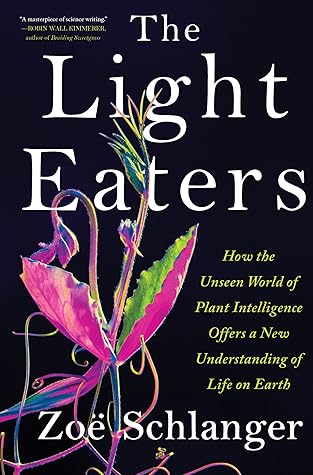More on this book
Community
Kindle Notes & Highlights
Thinking about this, I am reminded of the concepts of yang and yin, the philosophy of opposing forces. We know that the forces that shape life are in constant flux. The moth that pollinates the flower of a plant is the same species that devours the plants’ leaves when it is still a caterpillar. It is not, then, in the plant’s interest to completely destroy the grazing caterpillars that will metamorphose into the very creatures it relies on to spread its pollen.
The dangers of being immobile are precisely the forces that have driven plants to engineer some of the most impressive adaptations in nature. Perhaps a plant’s biggest achievement is its anatomical decentralization. A plant is modular; snap off a leaf, and it can grow a new one. Without a central nervous system to protect, the plants’ vital organs are distributed and come in duplicates.
Why, he asked, did the voracious caterpillars suddenly stop munching, leaving tree leaves intact? Why did they seem to abruptly die out? The answer, Rhoades discovered, was improbable, remarkable, and dangerous: the trees were communicating with each other. Trees the caterpillars hadn’t yet reached were ready; they’d turned their leaves into weapons. The caterpillars that ate them got sick and died.
Nature, never a flat plane, has always more folds and faces still hidden from human view. The world is a prism, not a window. Wherever we look, we find new refractions.
After all, in Appel’s work, a sound cue caused the plant to make its own pesticide. If plants could be made to produce pesticides through simply playing sounds to them, it could reduce or eliminate the need for synthetic pesticides on farms, and in some cases increase the levels of compounds that the crop in question is grown for. In a crop like mustard, for example, the plants’ own pesticide is the very thing it is farmed for—mustard oil. Putting a lavender bush on high alert by playing the right sounds would cause it to make more of the defensive compounds we prize in lavender oil.
As mentioned, Venus flytraps can count to five, and can store the memory of that counting at least as long as it takes to figure out if it has a fly in its maw or not. How it works is this: if two of the trigger hairs inside the flytrap’s trap are touched within twenty seconds of each other—a good indication that a living creature is moving around inside it—the trap snaps shut. But the flytrap keeps counting after it closes. If the trigger hairs are disturbed five times in quick succession—eliminating all doubt that it has caught a living, wriggling creature—the plant injects digestive juices
...more
Gianoli talks about the fact that termites were recently discovered to have microbes in their guts that make it possible for them to digest the chemicals in wood. In other words, the most signature behavior of termites—wood-eating—is made possible by entirely different organisms living within them. The termite’s gut microbes, in turn, are able to function thanks to yet smaller microbes that live within them.
In other words, parent plants can pass on skills for surviving in a tough world. In some cases this involves whole new body parts and coats of armor. For example, if yellow monkey flowers are exposed to predators, they will produce babies with a quiver of defensive spikes on their leaves.
In fact, genetic inheritance seems to explain only about 36 percent of the heritability of a person’s height, one of the physical traits that appears to be the most reliably related to the physical traits of your parents. Scientists call this perplexing phenomenon “missing heritability.” No one yet knows what fills the gap. “When will people like me stop teaching Mendelism as our model for genetics?” Sultan asked.
After a few algal bubble teas, the slug never needs to eat again. It begins to photosynthesize. It gets all the energy it needs from the sun, having somehow also acquired the genetic ability to run the chloroplasts, eating light, exactly like a plant. How this is possible is still unknown. Remarkably, the now-emerald-green slug is shaped exactly like a leaf, all but for its snail-like head. Its body is flat and broad and heart-shaped, and pointed at its tail end like a leaf tip. A web of leaflike veins branch across its surface. The slug orients its body in the same way a leaf does, angling
...more


